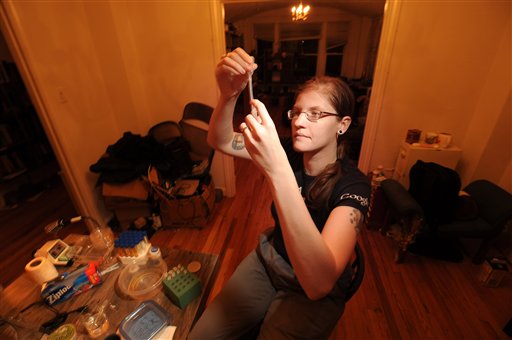Sustainable Food
|
|
****JavaScript based drop down DHTML menu generated by NavStudio. (OpenCube Inc. - http://www.opencube.com)****
|
| DIY-GE
Engineer your own plants.. You do know that you do not now need fancy labs to transfer genes from one plant to another? A kitchen will do. Remember both Apple computers and Google search engines were developed in garages.
Access to the relevant information and genes is bound to increase, because the science of genomics is in the public arena. Genomics maps out the amino acid bases of organisms, so we know where the genes are to do what. Plant breeding using genomics shuffles the packs like ordinary breeding, except the difference is the cards are turned upwards. We can see straight away the combinations that have been thrown up and pick what we want. This gives rise to a great diversity of options – compared with picking a single gene (or several – called stacking) and putting it the desired crop. However, DIY GE-ers can use this data to look for the run of bases (gene) that they want. This throws up all sorts of issues, one of which is whether there should be some sort of certification over this process to reduce safety risks. This seems quite feasible and the certification scheme would open up the possibility of proper training. However, it throws up the bigger issue of the control of GM / GE. It need not be in the hands only of big corporations and a few entrepreneurs. While it may start in a Californian kitchen, it could grow with all sorts of characters across the world. This would throw up a wide range of possible of problems that people consider need to be dealt with. The field we would be interesting in exploring is how to makew plants that are “more sustainable” – with all its variations in meaning. Instead of the “in-field yield” thinking of Monsanto, a wide diversity of issues among a very wide range of plants (and not just the few monocrops) could be thrown up. How about growing grapefruit in Glasgow to help diabetics reduce their food miles. Already linseed can produce more omega 3 oils. There must be hundreds of ideas for more nutritional, more sustainable food (intend to set up here for people to suggest ideas...) The chance for a small group getting approval in Europe is zero. The costs would be prohibitive. But this would not be the case in America, Africa, China or India. A great diversity of issues and genes could emerge and many could involve local solutions to local problems – the sort so far ignored by big business interests. The question that would then raise itself would be “who owns these new transgenic plants?”. How do plant engineers protect the ownership for locaal people? There is an international agreement (UPOV) that guides WTO member states to provide the ways to protect. |
| Copyright 2009 Environmental Practice at Work Publishing Co Ltd |


